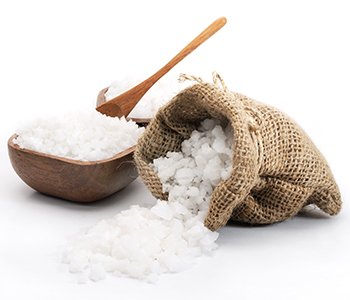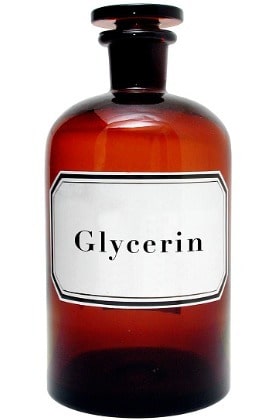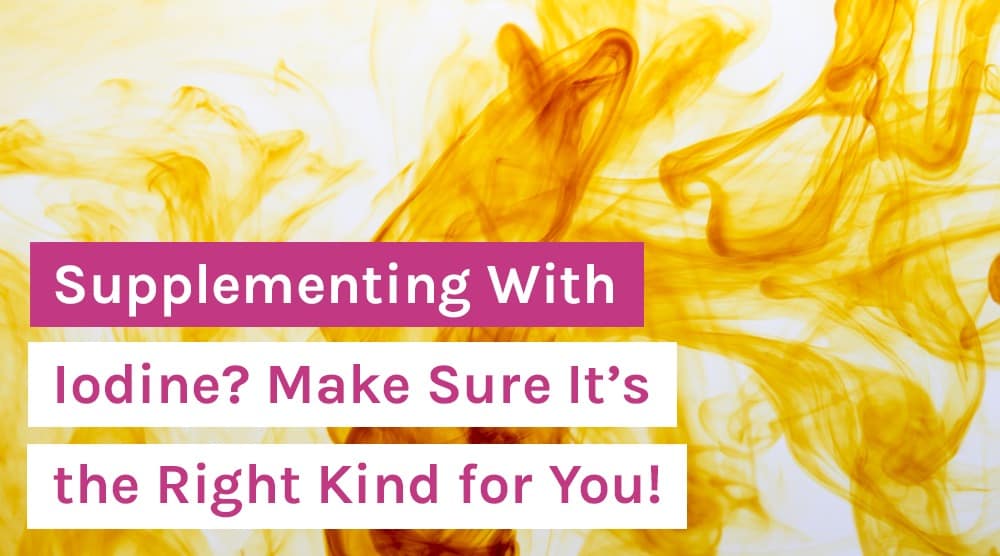Supplementing With Iodine? Make Sure It’s the Right Kind for You!
In a hurry? Click here to read the Article Summary...
Iodine is absolutely essential for every function in your body, including immune function, cardiovascular health, and metabolism. Of course, it’s most instrumental for the thyroid, since iodine is the foundation for thyroid hormone production.
According to the American Thyroid Association [1], close to half of the U.S. population suffers from lack of energy, temperature dysregulation, cognitive impairment, metabolic irregularity, and other conditions consistent with insufficient iodine intake.
The fact is that most of us need more iodine in our bodies. But what kind of iodine is right for you?
Iodine in Salt: Goiter Prevention and That’s About It
 You may find it hard to believe that Americans and the rest of the world are so deficient in iodine. After all, you may think, don’t they put iodine in table salt?
You may find it hard to believe that Americans and the rest of the world are so deficient in iodine. After all, you may think, don’t they put iodine in table salt?
It’s true that most people in the U.S. and the world get most of their iodine through salt. This poses more than one challenge, however. The first issue with consuming iodine from table salt is that you will not get enough.
The addition of iodine to the U.S. salt supply started in the 1920s in response to a government health mandate. During that time, up to 40% of the population of the upper Midwest and Great Lakes region suffered from goiters and other thyroid diseases caused by extreme iodine deficiency [2]. [Note: a goiter is an enlarged thyroid gland that results in a swelling of the neck.]
Adding iodine to table salt did help with the goiter epidemic, but that was about it. Nonetheless, it became the foundation upon which the U.S. RDA, or Recommended Daily Allowance (now called the Recommended Daily Intake, or RDI [3]) was built. Today, the RDI for iodine is 150 mcg/day for an adult and 220 mcg/day for a pregnant woman. This amount may stop goiters, but it’s not enough for all the iodine needs of the body.
Toxins in “Iodized” Table Salt
The second issue with table salt is the amount of toxins that are in it. This concern was not present in the 1920s when the mandate began, but has become a reality in the age of cutting corners for safety and health in the name of big profit. While salt in the 1920s still came from the sea or mineral deposits, today’s “iodized salt” is actually a man-made form of sodium called sodium chloride (with iodide added to it).
In order to make salt white and help it last longer, most manufacturers use a bleaching process. This adds dangerous halides such as chlorine and bromide to the mix, which block the body’s absorption of iodine. In addition, other chemicals are often added to the salt, including manufactured iodide, sodium solo-co-aluminate, fluoride sodium bicarbonate, anti-caking agents, and aluminum derivatives [4].
If you are going to sprinkle salt on your food, most health experts suggest Himalayan pink salt or Celtic sea salt, which contains trace amounts of naturally produced iodine as well as other essential minerals.
Is There Iodine in Food?
Okay, so if you can’t rely on table salt to provide you with enough iodine… what about the iodine in food? Long before there were supplements, people the world over were eating enough of the right kind of foods to get the iodine they needed, correct?
If you look at the situation from a historical perspective, this is absolutely true. Foods such as seaweed, sea food, fish, eggs, spinach, dairy, strawberries, and cranberries [5] have a high iodine load when compared to other foods. In the past, eating these foods with iodine would ensure healthy amounts of iodine in the body.
Zoom in on the last 20 years or so, however, and you will see a completely different picture. The depletion of nutrients in the soil, as well as an increasing toxic load, has changed the amount of essential nutrients available in the foods we eat.
Here is a case in point: In a multi-decade study, researchers at the University of Texas analyzed the nutritional components of 43 different vegetables and fruits grown in the U.S. between 1950 and 1999. The report, published in the Journal of the America College of Nutrition [6], discovered “reliable declines” in essential vitamins and minerals in 1999 compared to 1950 samples.”
Potassium Iodine in Tablet Form
 Iodine in tablet form comes in gel caps, pellets, and pills. For the most part, they are concentrates of dried kelp sources or similar substances. Molecularly, tablet form iodine is potassium iodide (KI), sodium iodide, molecular iodine, potassium iodate, sodium iodate or sodium iodine, or some combination of these.
Iodine in tablet form comes in gel caps, pellets, and pills. For the most part, they are concentrates of dried kelp sources or similar substances. Molecularly, tablet form iodine is potassium iodide (KI), sodium iodide, molecular iodine, potassium iodate, sodium iodate or sodium iodine, or some combination of these.
Potassium and sodium are often part of the picture because they act as carriers for iodine that the human body can safely absorb. Iodine in its natural state is unstable and even dangerous. Scientists discovered a while ago that combining potassium with iodine to form potassium iodide can create a more stable form, which can be absorbed by the body.
Molecular iodine, sometimes found in tablet form, is absorbed into the thyroid at a low rate but into breast tissue at a high rate. This makes molecular iodine a go-to for many who wish to help prevent breast-related conditions such as fibrocystic breast disease and breast cancer.
Researchers at Queen’s University Department of Surgery in Ontario, Canada, state in a report for the Canadian Journal of Surgery that “[the] results indicate the superiority of molecular iodine over iodides when treating fibrocystic breast disease [7].”
Research also shows that while potassium iodine cannot prevent radioactive iodine, or iodine-131, from being absorbed into the body, it can block its uptake into the thyroid immediately after high exposure. As the writers of Harvard Health, a publication of Harvard University, explain: “By flooding the body with non-radioactive iodine, the pills keep the gland from absorbing the radioactive iodine [8].”
KI is a very stable form of iodine, so by flooding the system with it right after exposure and over the next 24 hours, the thyroid gland can become “full” and will not take in any more iodine, radioactive or otherwise. This mechanism is why the World Health Organization [9] currently has protocols in place for “Iodine Prophylaxis” right after nuclear accidents. The main threats of events like Chernobyl and Fukushima is that when reactors leak, they will continue to spill radioactive Iodine-131 as well as cesium-137 into the environment for years after [10].
The downside regarding potassium iodine for everyday use is that only about 20% of this kind of iodine can be assimilated by the body.
Did you know that iodine is absolutely essential to every function in your body? Watch this video to learn how you can boost sluggish metabolism and energy.
Alcohol-Based vs Glycerin-Based Iodine
You may have noticed that some iodine supplements come in liquid form. These liquids are usually created by using either alcohol or glycerin.
The advantage of using a liquid for iodine transport is that it becomes more bioavailable to the body. Iodine in alcohol, however, is not the preferred method of liquid transport for several reasons.
First, most alcohol used for supplements are simple ethanol or grain alcohols, the same kind that the bartender puts in your favorite martini. Because of this, alcohol-based iodine may not be appropriate for young people, pets, those with high blood sugar, or those recovering from alcoholism.
In addition, almost all alcohols are made with genetically-modified corn and are not something you want to consume daily if you are striving for a healthy lifestyle [11].
On the other hand, glycerin (also known as glycerine, glycerol, or glycerite) has many advantages – that is, if you can find the right kind. Most commercial glycerin-based products, like commercial soaps, are sourced through animal products. A better option is vegetable-based glycerin. And the best of all is organic, non-GMO glycerin that is not made from soy or corn.
Organically-derived, vegetable-based glycerin has many advantages for both external and internal use. Unlike alcohol, which is a drying agent, glycerin retains moisture and does not evaporate in air. Glycerin can be a great salve for burns and is an antiseptic as well. It won’t upset blood sugar levels and, as a boon, iodine in glycerin has a much longer, more stable shelf life.
Nascent Iodine
Nascent iodine is also known as atomic iodine, monatomic iodine, Atomidine, or colloidal iodine. The term “nascent” refers to iodine that has an incomplete number of electrons. This gives it an electrical charge, according to a report conducted by the non-profit Weston Price Foundation [12] and others.
Nascent iodine’s charge is what makes it uniquely special. Many forms of dietary iodine break down into iodide in the digestive tract. In this state, iodine-dependent organs like the thyroid and reproductive organs cannot use it. The charge of nascent iodine helps it stay intact and absorb quickly and thoroughly into the organs that need it most.
High-absorption is most helpful for the thyroid because nascent iodine can help this important gland maintain homeostasis. A balanced, properly-working thyroid ensures that that the body is operating with overall vitality, health, and strong immune function.
Which Iodine Supplement Is the Best for You?
Iodine is perhaps the most important nutrient for your body to ensure total health. For the health of your thyroid, and every organ, make sure you are getting enough highly-absorbable, organic, nascent iodine every day.
You may have deduced by now which form of iodine is the absolute best for day-to-day consumption. That’s right: a nascent iodine in a non-GMO, organic, and vegetable-based glycerin solution carrier [13]. You can get all of this in Organixx organic Iodine.
When your organs are working hard to detoxify, you want the purest form of iodine possible to help them work more efficiently. It only makes sense to use an organic form that’s totally natural and free of chemicals. Organixx Iodine is one of the only formulas that is USDA Certified Organic. It’s a pure, nascent form of iodine which your thyroid can use immediately.

 Sources:
Sources:
Article Summary
Iodine is absolutely essential for every function in your body.
You will not get enough iodine by consuming table salt.
Foods such as seaweed, sea food, fish, eggs, spinach, dairy, strawberries, and cranberries have a high iodine load.
Molecular iodine is absorbed into the thyroid at a low rate but into breast tissue at a high rate.
Glycerin can be a great salve for burns and is an antiseptic as well.
Nascent iodine in a non-GMO, organic, vegetable-based glycerin solution carrier is suggested for day-to-day consumption.




a brilliant explanation, but just one thing. I have heard you should take iodine along side with Selenium.
How does iodine affect stage 3 kidney disease
I have been told that I have a hyperactive thyroid and I am not to take Iodine in any form.
When you research the use of Iodine you will see that there are two views about the use of iodine with hyperthyroid people. (I am also one).One view is to shun iodine. The other is this. Iodine has been used in the past to successfully rectify both hypo and hyper thyroid conditions. It depends why you have this condition. You cannot live without iodine. However when you are hyper your thyroid is spilling out iodine in huge amounts and not necessarily using to protect you. Your doctor who will possibly not be iodine literate will always advise you not to take iodine as that is what they have been taught. So your quest is to ask why. What other things should I investigate, because chances are behind your thyroid issue is a long and undetected set of issues. These may include Epstein Barr Virus sitting hidden in your thyroid, toxins such as heavy metals and pesticides in your thyroid or overloading your body, amalgams leaking mercury, pockets of toxins leaking into your body from root canals, fire retardents, bromide and fluoride in your food and water, and with all of these, issues with your gut microbiome. There are excellent reference books and articles about the use of iodine as well that you can read how to use iodine to heal. Be aware that you have the version of thyroid illness that requires more inquisitiveness as are less of us treading this path and there is less medical support other than surgery or RA.
Thanks for this comprehensive article on Iodine
Interesting! How does the variation of absorbencies between your nascent and traditional pill form affect dosing - a daily dose of 3 drops = 1950 mcgs compares how to a 6.25mg or 12.5 mg pill?? Thanks!
For me I use Sea Kelp have been for about ten years. I also keep Potassium Iodide just in case they drop a nasty bomb on use to keep Thyroid safe from the fall out .
I am curious how this iodine compares with Silica from Red Algae....does the Red Algae provide enough useable iodine on a daily basis. I do have Hashimoto's, Breast Cancer, SIBO, and residual issues from the cancer treatment so I am concerned about finding the right balance. Nobody seems to know how the body will assimilate iodine with such a compromised immune system and with gut dysbiosis. Thanks for any further information.